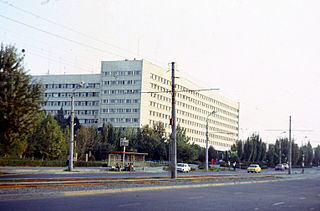
The 8th Guards Order of Lenin Combined Arms Army is an army of the Russian Ground Forces, headquartered in Novocherkassk, Rostov Oblast, within Russia′s Southern Military District, that was reinstated in 2017 as a successor to the 8th Guards Army of the Soviet Union's Red Army, which was formed during World War II and was disbanded in 1998 after being downsized into a corps. Military Unit в/ч 61877.

Long-Range Aviation (Russian: Авиация Дальнего Действия, tr.Aviatsiya dal'nego deystviya, literally Aviation of Distant Action and abbreviated DA, is a sub-branch of the Russian Aerospace Forces responsible for delivering long-range nuclear or conventional strikes by aircraft. The branch was previously part of the Soviet Air Forces and Russian Air Force tasked with long-range bombardment of strategic targets with nuclear weapons.

The 4th Guards Air and Air Defence Forces Army is an air army of the Russian Aerospace Forces, part of the Southern Military District and headquartered in Rostov-on-Don.

The Turkestan Military District was a military district of both the Imperial Russian Army and the Soviet Armed Forces, with its headquarters at Tashkent. The District was first created during the 1874 Russian military reform when by order of Minister Dmitry Milyutin the territory of Russia was divided into fourteen military districts. Its first commander was Konstantin Petrovich von Kaufmann, who was also Governor-General of Russian Turkestan at the time.

The Central Group of Forces was a formation of the Soviet Armed Forces used to incorporate Soviet troops in Central Europe on two occasions: in Austria and Hungary from 1945 to 1955 and troops stationed in Czechoslovakia after the Prague Spring of 1968.

The Transcaucasian Military District, a military district of the Soviet Armed Forces, traces its history to May 1921 and the incorporation of Armenia, Azerbaijan, and Georgia into the Soviet Union. It was disbanded by being redesignated as a Group of Forces in the early 1990s after the Soviet Union collapse. The military district formed as a basis of the modern day armed forces of Armenia, Azerbaijan, and Georgia as well as unrecognized polities of Abkhazia, the Republic of Artsakh and South Ossetia.

The Byelorussian Military District was a military district of the Soviet Armed Forces. Originally formed just before World War I as the Minsk Military District out of the remnants of the Vilno Military District and the Warsaw Military District, it was headed by the Russian General Eugen Alexander Ernst Rausch von Traubenberg.

The 16th Red Banner Air Army was the most important formation of the Special Purpose Command. Initially formed during the Second World War as a part of the Soviet Air Force, it was from its 2002 reformation to its 2009 disbandment the tactical air force component of the Moscow Military District. The 16th Air Army took part in the Battle of Berlin with 28 Aviation divisions and 7 Separate aviation regiments, and was located with the GSFG in East Germany until 1994. Withdrawn to Kubinka in that year, the army was disbanded and reformed as a corps in 1998. From 1949 to 1968, it was designated as the 24th Air Army.
The 37th Air Army of the High Supreme Command was the strategic bomber force of the Russian Air Force from 1998 to 2009. It was equipped with Tupolev Tu-95MS and Tu-160 armed with nuclear cruise missiles, and the intermediate range Tu-22M3 bombers.

The Transbaikal Military District was a military district of first the Soviet Armed Forces and then the Armed Forces of the Russian Federation, formed on 17 May 1935 and included the Buryat Republic, Chita Oblast, and Yakutia. Chita was the headquarters of the district. It was finally disbanded on 1 December 1998 by being amalgamated with the Siberian Military District, though Chita remained the headquarters of the new amalgamated district.
The 2nd Air Army was an air army of the Red Army Air Force during the Second World War.

The 76th Air Army was a unit of the Soviet Air Forces from 1949 to 1980, and again from 1988 to 1998. As the 13th Air Army, it was originally formed on 25 November 1942 and based on air units of the Leningrad Front.
The 14th Guards Combined Arms Army was a field army of the Red Army, the Soviet Ground Forces, and the Russian Ground Forces, active from 1956 to 1995. By the 1990s, according to sources within the 14th Army, the majority of its troops came from what would become the Pridnestrovian Moldavian Soviet Socialist Republic, with 51% of officers and 79% of draftees coming from this region.
The 65th Air Army DA was an air army of the Soviet Air Forces.
The 6th Air Army was an air army of the Red Army's Air Force during the Second World War and from 1946-1949. It was formed twice : in 1942 as part of the Red Army's Air Forces, and redesignated in 1944, and in 1946 and redesignated in 1949.
The 14th Air Army was an air army of the Soviet Air Forces during World War II and the Cold War and of the Ukrainian Air Force in the early Post-Soviet period.
The 240th Fighter Aviation Division was a fighter aircraft formation of the Soviet Air Forces during World War II. It saw its most eventful actions during that war, and in 1949 became the 119th Fighter Aviation Division.
Voznesensk is an reserve air base of the Ukrainian Air Force located near Voznesensk, Mykolaiv Oblast, Ukraine.












